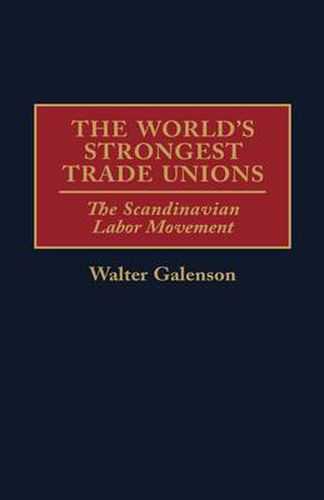Readings Newsletter
Become a Readings Member to make your shopping experience even easier.
Sign in or sign up for free!
You’re not far away from qualifying for FREE standard shipping within Australia
You’ve qualified for FREE standard shipping within Australia
The cart is loading…






Despite the general decline of trade unions throughout the Western world, unions in Denmark, Norway and Sweden have prospered. Why? This book cites their ability to organize white collar workers, the special attention they give to recruitment of women, and their ability to undergo structural change under employer pressure. It analyzes these factors in the belief that if unions in other parts of the world understand why and how unionism is succeeding in Scandinavia, its deterioration may be slowed and even reversed. In doing so, Galenson offers specific advice on how industrial relations professionals should manage to avoid breakdown of existing systems elsewhere. Labour unions, officials and organization executives, as well as executives throughout the public sectors, should find Galenson’s views informative and enlightening. This is an account of how unions in the Scandinavian countries have managed to secure the world’s highest rates of organization: up to 90 per cent of all who are employed in Sweden, and somewhat less in Denmark and Norway, are trade union members, compared with 15per cent in the United States. The countries in which they operate are welfare states and are among the wealthiest countries in the world, yet remarkably little is known about the systems of industrial relations that have contributed to these results. Galenson’s book should fill that gap and in doing so, make a contribution to the determination of policy in other countries.
$9.00 standard shipping within Australia
FREE standard shipping within Australia for orders over $100.00
Express & International shipping calculated at checkout
Despite the general decline of trade unions throughout the Western world, unions in Denmark, Norway and Sweden have prospered. Why? This book cites their ability to organize white collar workers, the special attention they give to recruitment of women, and their ability to undergo structural change under employer pressure. It analyzes these factors in the belief that if unions in other parts of the world understand why and how unionism is succeeding in Scandinavia, its deterioration may be slowed and even reversed. In doing so, Galenson offers specific advice on how industrial relations professionals should manage to avoid breakdown of existing systems elsewhere. Labour unions, officials and organization executives, as well as executives throughout the public sectors, should find Galenson’s views informative and enlightening. This is an account of how unions in the Scandinavian countries have managed to secure the world’s highest rates of organization: up to 90 per cent of all who are employed in Sweden, and somewhat less in Denmark and Norway, are trade union members, compared with 15per cent in the United States. The countries in which they operate are welfare states and are among the wealthiest countries in the world, yet remarkably little is known about the systems of industrial relations that have contributed to these results. Galenson’s book should fill that gap and in doing so, make a contribution to the determination of policy in other countries.